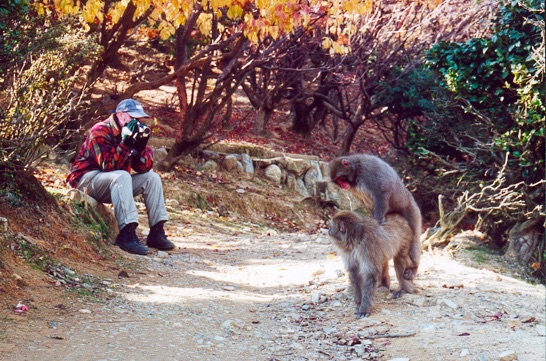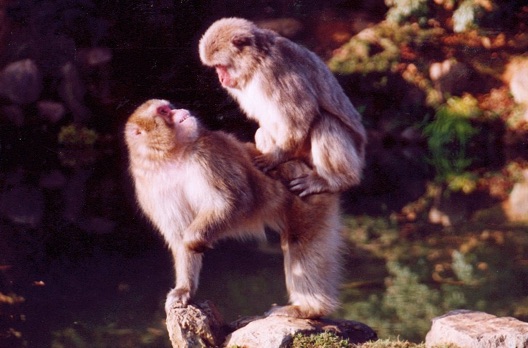Japanese Macaque Research

From 2000-2012, my lab members and I conducted annual fieldwork each autumn on the non-conceptive sexual behavior of free-ranging Japanese macaques at Arashiyama, Japan. Prior to that I conducted research for five years on a captive group culled from the Arashiyama population. Females in the Arashiyama population routinely court and mount each other during temporary, but exclusive sexual relationships termed “consortships." From 2012-2015, we conducted research at two other sites: Jigokudani (in the Japanese Alps near Nagano) and Minoo (near Osaka).
Do females just engage in these behaviours because they can't get a male?
No. Males actively solicit homosexually consorting females, but the females routinely ignore or rebuff these males suitors.
Female Japanese macaques that engage in homosexual consortships are almost invariably solicited for sex by males. Overwhelmingly, male sexual solicitations are ignored or actively repelled by homosexually consorting females who choose, instead, to pursue sexual activity with each other.
While it is true that female homosexual behaviour increases in frequency as the number of males in the population decreases, such increases likely reflect the fact that there are fewer male sexual competitors under these demographic conditions and more preferred female sexual partners, relative to preferred male sexual partners.
Further Reading:
Leca, J-B., Gunst, N., Huffman, M.A. & Vasey, P.L. (2015). Effect of female-biased sex ratios on female homosexual behavior in Japanese macaques: Evidence for the “Bisexual Preference Hypothesis.” Archives of Sexual Behavior, 44: 2125-2138.
Vasey, P.L. (2002). Sexual partner preference in female Japanese macaques. Archives of Sexual Behavior, 31: 45-56.
Vasey, P.L. & Gauthier, C. (2000) Skewed sex ratios and female homosexual activity in Japanese macaques: An experimental analysis. Primates, 41: 17-25.
Vasey, P.L. (1998). Female choice and inter-sexual competition for female sexual partners in Japanese macaques. Behaviour, 135: 579-597.
Do females just engage in these behaviours to express dominance or to achieve some other social aim?
No. There is no evidence that female Japanese macaques use homosexual behaviour to mediate adaptive social goals.
Female homosexual behaviour in Japanese macaques does not function to facilitate a variety of "sociosexual" goals including, but not limited to: (1) alliance formation, (2) communication about dominance relationships, and (3) reconciliation following conflicts. At the same time, there is no evidence that homosexual behaviour is maladaptive because it does not appear to impede successful reproduction by females of this species.
Further Reading:
Vasey, P.L. (2004). Pre- and post-conflict interactions between female Japanese macaques during homosexual consortships. International Journal of Comparative Psychology, 17: 351-359.
Vasey, P.L., Chapais, B., Gauthier, C. (1998). Mounting Interactions between female Japanese macaques: Testing the influence of dominance and aggression. Ethology, 104: 387-398.
Vasey, P.L. (1996). Interventions and alliance formation between female Japanese macaques (Macaca fuscata) during homosexual consortships. Animal Behaviour, 52: 539-551.
Is female-female courtship, mounting and consorting in Japanese macaques really sexual?
Yes. Numerous lines of evidence indicate that these behaviours really are sexual.
Firstly, female-female sexual behaviour in this species mirrors male-female sexual behavior in many aspects of its expression. For example, patterns of courtship during homosexual consortships closely parallels the patterns observed during heterosexual consortships.
Second, these interactions do not mimic generalized patterns of social affiliation. For example, females exercise incest avoidance with close female kin, such that mounting, courtship, and consortships are never observed between mothers and daughters, sisters, or grandmothers and granddaughters . This pattern of avoidance does not characterize other forms of affiliation that are widely recognized as social, such as grooming, co-sleeping, huddling, and conflict interventions.
Third, female mounters engage in repetitive and direct stimulation of the vulvar, perineal and anal regions during the majority (78.3%) of female-female mounts.
Further Reading:
Vasey, P.L., Rains, D., VanderLaan, D.P., Duckworth, N., & Kovacovsky, S.D. (2008). Courtship behavior during heterosexual and homosexual consortships in Japanese macaques. Behavioral Processes, 78: 401-407.
Vasey, P.L. & Duckworth, N. (2006). Sexual reward via vulvar, perineal and anal stimulation: A proximate mechanism for female homosexual mounting in Japanese macaques. Archives of Sexual Behavior, 35: 523-532.
Chapais, B., Gauthier, C., Prud'homme, J. & Vasey, P.L. (1998). Relatedness threshold for nepotism in Japanese macaques. Animal Behaviour, 53: 1089-1101.
Have these female Japanese macaques somehow been "masculinized" during their development?
Beyond engaging in "male-typical" mounting behaviour and even choosing same-sex sexual partners over male alternatives, female Japanese macaques in the Arashiyama population do not appear to be male-typical in terms of their brains or other aspects of their behaviour.
Although female Japanese macaques routinely mount same-sex partners, the postures and pelvic movements they employ during such interactions are not a male-typical manner. Female Japanese macaques do not employ male-typical strategies, such as consort intrusions and sexual coercion, to acquire female sexual partners. Likewise, inter-mount social behaviour is overwhelmingly female-typical in expression. Neuroanatomical research that I conduced with Jim Pfaus on archived brains indicates that a subdivision of their hypothalamus (one of the areas of the brain that regulates sexual behaviour) is no more male-typical than that of female rhesus macaques, a closely related sister species in which females do not display male-typical sexual behaviour with the same regularity as Japanese macaques.
Further Reading:
Vasey, P.L., VanderLaan, D.P., Rains, D., Duckworth, N., & Kovacovsky, S.D. (2008). Inter-mount social interactions during heterosexual and homosexual consortships in Japanese macaques. Ethology, 114: 564-574.
Vasey, P.L., Foroud, A., Duckworth, N. & Kovacovsky, S.D. (2006). Male-female and female-female mounting in Japanese macaques: A comparative analysis of posture and movement. Archives of Sexual Behavior, 35: 116-128.
Vasey, P.L. & Pfaus, J.G. (2005). A sexually dimorphic hypothalamic nucleus in a macaque species with frequent female-female mounting and same-sex sexual partner preference. Behavioural Brain Research, 157: 265-272.
Vasey, P.L. (2004).Sex differences in sexual partner acquisition, retention and harassment during female homosexual consortships in Japanese macaques. American Journal of Primatology, 64: 397-409.
The evolutionary history of female homosexual behaviour in Japanese macaques
On the basis of my previous research, I have argued that female homosexual behaviour in Japanese macaques is a neutral sexual behaviour that is a by-product of an adaptation. I have hypothesized that (1) female-male mounting evolved as an adaptation that females use to control the movement of males in a context of high female-female competition for male males; (2) females derive immediate sexual reward from mounting via vulvar stimulation; and (3) female homosexual behaviour evolved as a neutral by-product of selection for female-male mounting and, as a result of the proximate ability of females to derive immediate sexual reward from mounting. I am currently working with Drs. Jean-Baptiste Leca and Noëlle Gunst, to further test this hypothesized evolutionary history for female mounting in Japanese macaques.
Further Reading:
MacFarlane, G.R. & Vasey, P.L. (2016). Promiscuous primates engage in same-sex genital interactions. Behavioral Processes, 126: 21-26.
Ottenheimer Carrier, Leca, J.-B., Pellis, S. & Vasey, P.L. (2015). A structural comparison of female-male and female-female mounting in Japanese macaques (Macaca fuscata). Behavioural Processes, 119: 70-75.
Leca, J-B., Gunst, N., Ottenheimer-Carrier, L. & Vasey, P.L. (2014). Intergroup variation in non-conceptive mounting behavior in Japanese macaques: Could it be cultural? Animal Behavior and Cognition, 1(3): 381-405.
VanderLaan, D.P., Pellis, S. & Vasey, P.L. (2012). A theoretical model of the development and evolution of non-conceptive mounting behavior in Japanese macaques. In: Leca, J.B., Huffman, M.J., & Vasey, P.L.(eds.). The Monkeys of Stormy Mountain: Over Half a Century of Research on the Arashiyama Macaques, pp. 86-203. Cambridge: Cambridge University Press.
Vasey, P.L. & Jiskoot, H. (2010). The biogeography and evolution of female homosexual behavior in Japanese macaques. Archives of Sexual Behavior, 39: 1439-1441.
Vasey, P.L. & Reinhart, C. (2009). Female homosexual behavior in a new group of Japanese macaques: Evolutionary implications. Laboratory Primate Newsletter, 48(3): 8-10.
Vasey, P.L. & Duckworth, N. (2008). Female-male mounting in Japanese macaques: The proximate role of sexual reward. Behavioural Processes, 77: 405-407. (Selected as a “recommended article” by the journal Editors).
Inter-sexal mate competition
My research indicates that Japanese macaques compete inter-sexually for sexual partners, and raise the possibility that competition for reproductive partners may occur inter-sexually as well. The next step in this line of inquiry is to determine whether: (1) male Japanese macaques compete inter-sexually for ovulating females; and whether (2) ovulating females choose same-sex sexual partners over male reproductive partners, as well as (3) compete inter-sexually for female sexual partners. This work is being conducted with Drs. Jean-Baptiste Leca and Noëlle Gunst.
Further Reading:
Vasey, P.L., Leca, J-B., Gunst, N. & VanderLaan, D.P. (2014). Female homosexual behavior and inter-sexual mate competition in Japanese macaques: Possible implications for sexual selection theory. Neuroscience and Biobehavioral Reviews, 46: 573-578.
Vasey, P.L. (1998). Female choice and inter-sexual competition for female sexual partners in Japanese macaques. Behaviour, 135: 579-597.
The development of mounting in Japanese macaques
Adolescence is a period in which sexual behaviors are gradually acquired by female Japanese macaques. However, sexual activity develops much faster in a homosexual context than a heterosexual one. This developmental schism is likely owing to the fact that adult males routinely direct aggression toward proceptive adolescent females, whereas adult females solicit them for sex. Moreover, adolescent females gradually learn to execute mount postures that facilitate genital stimulation during same-sex mounts which provides a proximate motivation for engaging in them.
Same-sex mounting between juvenile male Japanese macaques occurs within the males’ mixed-sex natal groups. Mounting partners tend to be each other’s preferred affiliates outside of mounting interactions. During play bouts juvenile male-male mounting is enacted to acquire the attention of mountees. By the age of three many juvenile males disperse from their natal communities and join all-male groups within which they form sexual consortships with subadult and adult males.
Further Reading:
Leca, J-B., Gunst, N., & Vasey, P.L. (2015). Comparative development of heterosexual and homosexual behaviors in free-ranging female Japanese macaques. Archives of Sexual Behavior, 44: 1215-1231.
Gunst, N., Leca, J-B., & Vasey, P.L. (2015). Influence of sexual competition and social context on homosexual behavior in adolescent female Japanese macaques. American Journal of Primatology, 77: 502-515.
Leca, J-B., Gunst, N., & Vasey, P.L. (2014). Development of sexual behaviors in female Japanese macaques. Developmental Psychobiology, 56: 1199–1213.
Leca, J-B., Gunst, N., & Vasey, P.L. (2014). Development of sexual behaviors in female Japanese macaques. Developmental Psychobiology, 56: 1199–1213.
Günst, N., Leca, J-B, & Vasey, P.L. (2013). Development of heterosexual and socio-sexual mounting in free-ranging juvenile male Japanese macaques (Macaca fuscata). Behaviour, 150: 1225-1254.
VanderLaan, D.P., Pellis, S. & Vasey, P.L. (2012). A theoretical model of the development and evolution of non-conceptive mounting behavior in Japanese macaques. In: Leca, J.B., Huffman, M.J., & Vasey, P.L.(eds.). The Monkeys of Stormy Mountain: Over Half a Century of Research on the Arashiyama Macaques, pp. 86-203. Cambridge: Cambridge University Press.
Paul L. Vasey videotapes two female Japanese macaques performing a double-foot clasp mount at Arashiyama, Japan
Female-female sitting mount by Japanese macaques at Arashiyama, Japan.


